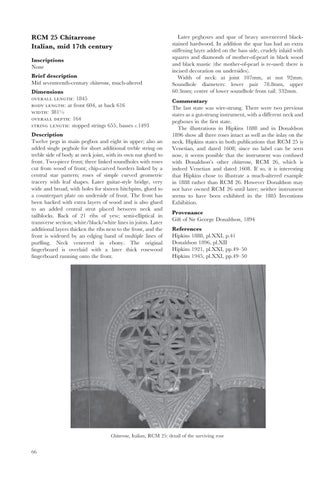50731-053-086
3/4/07
14:35
Page 66
RCM 25 Chitarrone Italian, mid 17th century Inscriptions None Brief description Mid seventeenth-century chitarrone, much-altered Dimensions : 1845 : at front 604, at back 616 : 381½ : 164 : stopped strings 655, basses c.1493 Description Twelve pegs in main pegbox and eight in upper; also an added single peghole for short additional treble string on treble side of body at neck joint, with its own nut glued to front. Two-piece front; three linked soundholes with roses cut from wood of front; chip-carved borders linked by a central star pattern; roses of simple curved geometric tracery with leaf shapes. Later guitar-style bridge, very wide and broad, with holes for sixteen hitchpins, glued to a counterpart plate on underside of front. The front has been backed with extra layers of wood and is also glued to an added central strut placed between neck and tailblocks. Back of 21 ribs of yew; semi-elliptical in transverse section; white/black/white lines in joints. Later additional layers thicken the ribs next to the front, and the front is widened by an edging band of multiple lines of purfling. Neck veneered in ebony. The original fingerboard is overlaid with a later thick rosewood fingerboard running onto the front.
Later pegboxes and spar of heavy unveneered blackstained hardwood. In addition the spar has had an extra stiffening layer added on the bass side, crudely inlaid with squares and diamonds of mother-of-pearl in black wood and black mastic (the mother-of-pearl is re-used: there is incised decoration on undersides). Width of neck: at joint 107mm, at nut 92mm. Soundhole diameters: lower pair 78.8mm, upper 60.3mm; centre of lower soundhole from tail: 332mm. Commentary The last state was wire-strung. There were two previous states as a gut-strung instrument, with a different neck and pegboxes in the first state. The illustrations in Hipkins 1888 and in Donaldson 1896 show all three roses intact as well as the inlay on the neck. Hipkins states in both publications that RCM 25 is Venetian, and dated 1608; since no label can be seen now, it seems possible that the instrument was confused with Donaldson’s other chitarrone, RCM 26, which is indeed Venetian and dated 1608. If so, it is interesting that Hipkins chose to illustrate a much-altered example in 1888 rather than RCM 26. However Donaldson may not have owned RCM 26 until later; neither instrument seems to have been exhibited in the 1885 Inventions Exhibition. Provenance Gift of Sir George Donaldson, 1894 References Hipkins 1888, pl.XXI, p.41 Donaldson 1896, pl.XII Hipkins 1921, pl.XXI, pp.49–50 Hipkins 1945, pl.XXI, pp.49–50
Chitarrone, Italian, RCM 25: detail of the surviving rose 66
